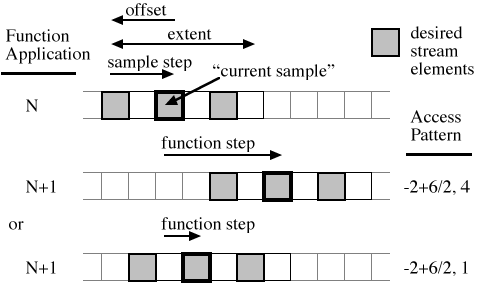



Next: Pipelined Function Application
Up: Functions
Previous: Functions
Index

A Stream Access Pattern
A function reads one or more stream elements from each input stream
and writes one or more stream element to each output stream. In order
that functions may be executed in a non-blocking manner, the Q ISA
requires that the set of stream elements, or stream access pattern,
accessed in one function invocation be identified for each stream
input or output parameter.
An access pattern spans a specified number of a function's bound
dimensions, and is specified with locations relative to a function
specific origin, typically located within the set. Nulladic3 input or output parameters are located at this origin, which
represents the ``current'' location when a function is invoked.
In order to minimize the complexity and size of the access pattern
representation, it is defined as being the ``bounding box'' of the
locations of all set elements for a given parameter. More
specifically, it is the orthotope4 that includes all
accessed locations.
An access pattern defines the following parameters per specified dimension:
- offset indicates where the start of the access pattern along
a dimension is located relative to the ``current''
location.
- extent indicates the size of the access pattern, in
distance along the dimension -- not actual number of samples,
which is indicated by extent divided by step.
A negative extent indicates that the region starts at
offset (including it) and extends in the earlier direction.
- sample step indicates the increment between adjacent
samples along this dimension. If zero, the same value will be
accessed extent times.
- function step indicates the increment between adjacent
applications of the function, along this dimension. If zero, then the
offset is absolute (not relative) and the indicated region is the
only one of interest.
- dimension indexes which of the function's bound
dimensions this dimension in the access pattern represents.
The order in which dimensions are defined in an access pattern
indicates the desired ordering of the sequence of stream elements
accessed by the function. This information is required when a processor
utilizes a decoupled memory access mechanism.
It is a common situation for a stream access pattern to be
variable, or dependent on the actual data being input. In
this case, the access pattern specifies the bounding box of the union
of possible sets of stream elements. Upon function termination, the
stream fragments passed as parameters will be modified to communicate
to the runtime system the number of elements actually consumed along
each dimension. Functions with variable access patterns must be
explicitly parallelized in an application specific manner, as there is
no general solution to the data dependency problem posed. Several Q
primitive functions (e.g. resample support access patterns
which vary as functions of another function input parameter.
Footnotes
- ...3
- The ``Greek'' terms (monadic, dyadic, etc...) will be
used when referring to the number of dimensions, and the ``Latin''
terms (unary, binary, etc...) will be used to refer to the number
of input parameters, as suggested by Ashcroft, et al[2]
- ... orthotope 4
- An orthotope is a
multidimensional generalization of the rectangular parallelepiped. It
is a point, line, rectangle, and rectangular parallelepiped in zero,
one, two, and three dimensions, respectively.




Next: Pipelined Function Application
Up: Functions
Previous: Functions
Index
magiceight-web@media.mit.edu

